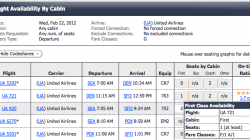Any time I speak about Alaska Airlines at Frequent Traveler University or other seminars, the most questions center around the companion fare. Understandably so. It’s a great deal and I think some people just don’t believe it. Many companion fares from other airlines or credit card issuers have restrictions tacked on. Maybe you need to buy a more expensive refundable ticket for the primary passenger, or the companion ticket needs to be booked using much more limited award space. It could be that it has to be a simple round-trip itinerary to be eligible.
Those rules don’t apply to the companion fare you get with the Alaska Airlines Visa Signature card. You can use it for just about any itinerary — one-way, round-trip, open jaw, multi-city — and BOTH tickets remain eligible for upgrades and earning miles. It’s really just a discounted fare of $99 plus taxes and fees, which tend to be minimal since Alaska doesn’t fly long-haul international routes. Read more in my PowerPoint presentation from FTU DC.
Limitations of the Alaska Companion Fare
One big change happened a couple years ago when Alaska did limit the companion fare to itineraries booked in economy class. It used to be you could use it for first or economy class, so you could get two first class tickets for the price of one. But even with this rule, you can still easily book you and your companion into first class if you each have some kind of elite status with Alaska. And if you don’t have status, you may be able to instead upgrade yourselves with 15,000 miles each. This is because the companion will book into the same booking class as the primary passenger — both will have upgrade-eligible fares. To find this code, just log in to your Alaska Airlines account, find the “Discount Codes” section on the left sidebar, and click on the “Valid” link.
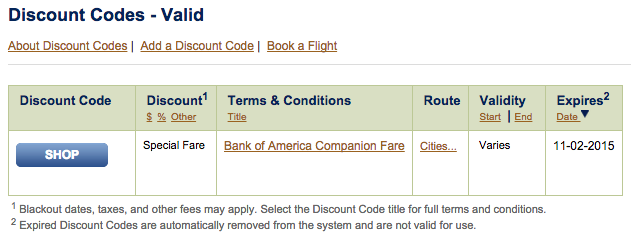
Certain booking classes are eligible for instant upgrades, and Alaska makes it very easy to search for these on its website. Simply select the type of upgrade you want. A colored “U” will appear next to flights that have an instant upgrade available. If you don’t see it, you may still be able to book now and check back later to upgrade when availability changes.
Upgradeable Fares Are Easy to Search For
To demonstrate how affordable it can be to book first class fares in this manner, I did a sample search for a trip from San Jose to Maui this winter. I’m doing this first without the companion fare discount code, but I did select an upgrade from the left sidebar. My wife and I each have MVP Gold status. If you have miles or are using a friend’s MVP Gold Guest upgrade, choose that option instead because there may be different fare class restrictions and thus different prices displayed.
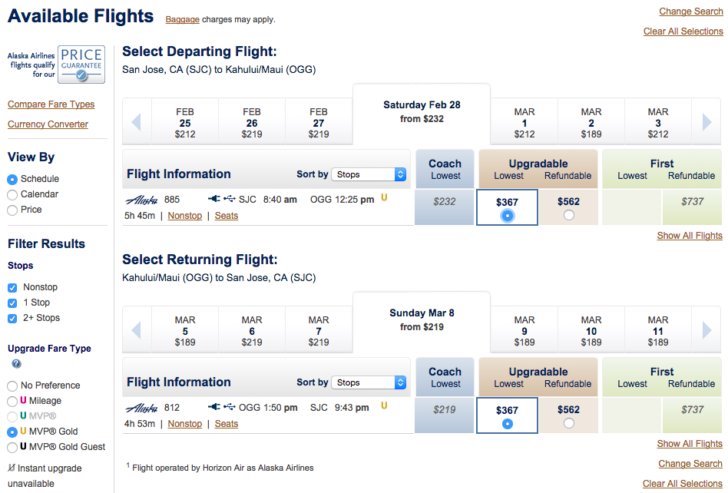
Note that a yellow “U” appears next to each flight. If you have a connecting flight, you’ll want to look for a “U” next to every segment on the itinerary.
I like that Alaska shows not only the upgradeable fare I want to book but also the cheapest fare and the normal first class fare. This lets me know just how good a deal I’m getting. Maybe if the price is drastically lower I would prefer to give up my instant upgrade and hope for a complimentary upgrade close to departure. Or if a true first class seat isn’t much pricier, I could pay up and earn bonus miles for that booking class. (Since I’m trying to use a companion fare in this example, actually paying for first class isn’t an option — the companion fare wouldn’t apply.)
The prices above are only the base fare. Click through to the next page to see the total cost. I clicked on the link to display a breakdown of the base fare, taxes, and fees.
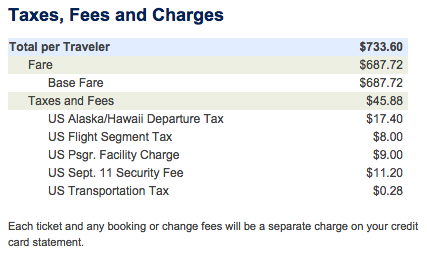
The total price is $733.60 per person, or $1,467.20. I remember back during the recession you could find $300 fares or less! For comparison, booking the cheapest fare without an instant upgrade would be $450.60 each or $901.20 for two people. I would not pay roughly $300 per person for an upgradeable ticket, though I might do it if this were a connecting itinerary. Keep in mind it is still cheaper than paid first class, at $1,473.60 each or $2,947.20. The upgradeable fare is half as much as a normal first class fare.
The Itinerary I Want Can’t Be Upgraded!
I originally wrote this post using an example from Seattle to Maui that connected in San Jose because it was a quick and dirty search meant only to show the relative affordability of using a companion fare on an upgradeable itinerary. One reader commented that it wasn’t really a fair analysis because I overlooked a cheaper non-stop flight from Seattle (which couldn’t be upgraded). I’ve made some changes obviously, but I think debating whether there’s a cheaper flight — somewhere, sometime, some other carrier — is beside the point. You can almost always find a cheaper or better itinerary somewhere else, though I did manage to find some upgradeable non-stop fares on a different date.
The real point is, with the instructions in this post you can probably find something you like and confirm an upgrade into first class even if the companion fare can’t actually be used to book first class tickets anymore. And if you find an itinerary you like where the fare isn’t upgradeable immediately (the “U” is not present), you may be able to upgrade later.
Applying the Companion Fare Discount
Now let’s see what happens we repeat the search above using a companion fare.
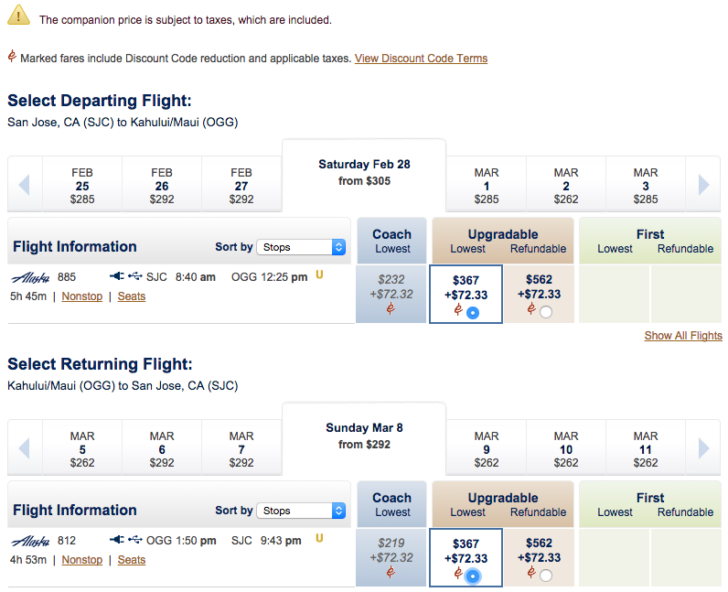
The prices you see here are for the primary traveler ($367 each way) plus the companion fare, taxes, and fees for the companion ($72.33 each way). The little “e” icon is a standard symbol Alaska Airlines uses when a fare is eligible for a discount, whether that’s the companion fare or any other online discount code.
On the next page we see the breakdown for each person including taxes and fees. The “$99 companion fare” is actually $144.64 when taxes and fees are included. Visiting Hawaii isn’t cheap. But you could pay much less if you were interested in a mainland destination and making no connections, each of which adds additional segment taxes.
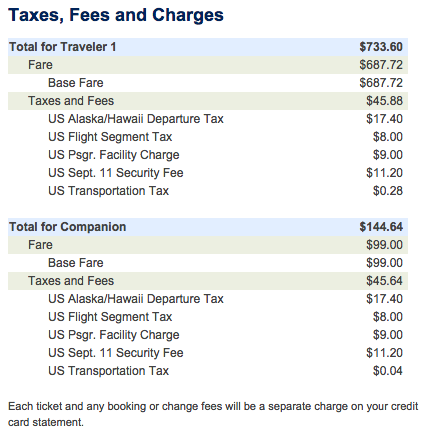
I also looked at what it would cost in a hypothetical scenario if you could still book a true first class ticket and apply a companion fare (adding $99 plus the taxes and fees). That would work out to $1,618.78 for two passengers with this itinerary.
Comparing Options
Let’s compare prices now for the three fare types discussed above — cheapest, upgradeable, and first class — when we look at them with and without a companion fare. Remember that you can’t actually use a companion fare on a first class itinerary any more, but I can estimate what it would cost.
| Cheapest Itinerary | $901.20 |
| Cheapest Itinerary with Companion Fare | $595.36 |
| Upgradeable Itinerary | $1,467.20 |
| Upgradeable Itinerary with Companion Fare | $878.24 |
| First Class Itinerary | $2,947.20 |
| First Class with Companion Fare (Hypothetical) | $1,618.78 |
As you can see, booking an upgradeable itinerary with a companion fare is actually cheaper than if we had booked the cheapest itinerary without the companion fare. If you have a companion fare available, I definitely recommend looking at your options for upgrading your flight in advance. You eat into your savings by paying for a more expensive ticket. But remember that only one of the tickets increases in price. The companion’s fare remains a flat $99 plus taxes and fees.
You’re still paying more than if you used a companion fare on the cheapest itinerary without an instant upgrade. I’ll grant you that. But this isn’t about how to pay the least amount to get to your destination. It’s about finding a great compromise between value and comfort. I wasn’t originally willing to pay a premium of ~$300 per person for an upgradeable itinerary. With a companion fare, the difference between the cheapest and the upgradeable fare is closer to ~$140 per person.
You’re also paying much less than if a companion fare were still valid for first class under the old rules. Adding that restriction was not a major blow to the companion fare in my opinion. It’s much cheaper — then and now — to book yourself into economy class and then apply an instant upgrade.

